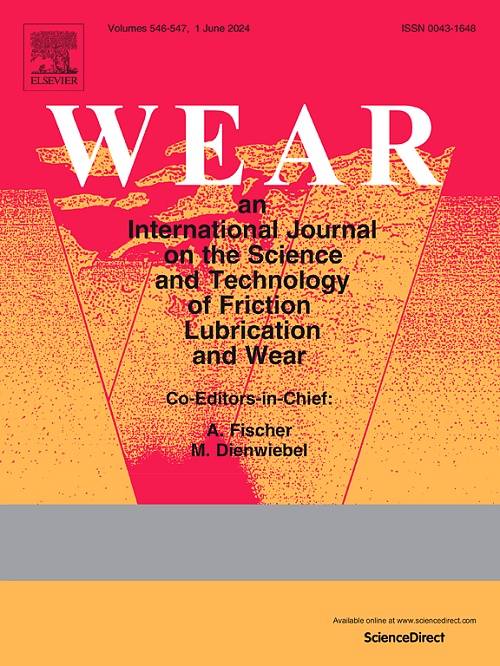Use of a novel sensor to investigate the complicated boundary between biotribology and surface topology and their impact on tactile graphic perception
IF 6.1
1区 工程技术
Q1 ENGINEERING, MECHANICAL
引用次数: 0
Abstract
For persons with blindness or significant visual impairment, access to tactually encoded information is vital for full engagement in society. The use of Braille as a tactile communication system for textual information is ubiquitous and standardized. For graphically intensive information such as charts, diagrams and maps, tactile graphics are often employed which encode visual cues via the use of topological features. In contrast to Braille, there is far less standardization of tactile graphics practices because less work has been done to fully understand the complex interplay of biotribology, surface topology and printing technology, which all impact graphic legibility. Previous work by the authors has shown that friction plays a substantial role in tactile perception in some cases, while – counterintuitively – it does not appear to be the dominant perceptual differentiating mechanism with common texture types used in tactile graphics. In this work, the authors evaluated an evidenced-based hypothesis to explain the perceptive ability of evaluators to properly differentiate among select texture patterns that could not be explained by purely friction or wear-based mechanisms. A specialized analytical contact model was employed to predict the number of texture elements in contact with a sliding fingertip as a means to explain previous findings that the inter-element spacing was crucial to perception. A novel sensor was developed which employed electro-active textural elements printed on paper media to confirm the analytical results. Topologically flat texture analogues were also developed to explore the impact of topology on the number of elements in contact during tactile graphic exploration. This approach enabled the authors to determine the texture parameters where tribological effects began to transition to topological impacts. These findings have application to not only optimal tactile graphic design but also to improving the wear and durability of printed graphics on paper media.
利用一种新型传感器研究生物摩擦学与表面拓扑之间的复杂边界及其对触觉图形感知的影响
对于失明或有严重视力障碍的人来说,获得实际编码的信息对于充分参与社会至关重要。使用盲文作为文本信息的触觉交流系统是普遍和标准化的。对于图形密集型信息,如图表、图表和地图,通常采用触觉图形,通过使用拓扑特征对视觉线索进行编码。与盲文相比,触觉图形实践的标准化程度要低得多,因为在充分理解生物摩擦学、表面拓扑和印刷技术之间复杂的相互作用方面所做的工作很少,而这些都影响着图形的易读性。作者之前的研究表明,在某些情况下,摩擦在触觉感知中起着重要作用,而与直觉相反,它似乎并不是触觉图形中常用纹理类型的主要感知区分机制。在这项工作中,作者评估了一个基于证据的假设,以解释评估者的感知能力,以正确区分无法由纯粹的摩擦或磨损机制解释的纹理模式。一个专门的分析接触模型被用来预测与滑动指尖接触的纹理元素的数量,作为解释先前发现元素间间距对感知至关重要的一种手段。研制了一种新型传感器,利用印刷在纸质介质上的电活性织构元件来验证分析结果。拓扑学平面纹理类似物也被开发出来,以探索在触觉图形探索过程中拓扑学对接触元素数量的影响。这种方法使作者能够确定摩擦学效应开始过渡到拓扑影响的纹理参数。这些发现不仅可以用于优化触觉图形设计,还可以用于提高纸质印刷图形的耐磨性和耐久性。
本文章由计算机程序翻译,如有差异,请以英文原文为准。
求助全文
约1分钟内获得全文
求助全文
来源期刊

Wear
工程技术-材料科学:综合
CiteScore
8.80
自引率
8.00%
发文量
280
审稿时长
47 days
期刊介绍:
Wear journal is dedicated to the advancement of basic and applied knowledge concerning the nature of wear of materials. Broadly, topics of interest range from development of fundamental understanding of the mechanisms of wear to innovative solutions to practical engineering problems. Authors of experimental studies are expected to comment on the repeatability of the data, and whenever possible, conduct multiple measurements under similar testing conditions. Further, Wear embraces the highest standards of professional ethics, and the detection of matching content, either in written or graphical form, from other publications by the current authors or by others, may result in rejection.
 求助内容:
求助内容: 应助结果提醒方式:
应助结果提醒方式:


